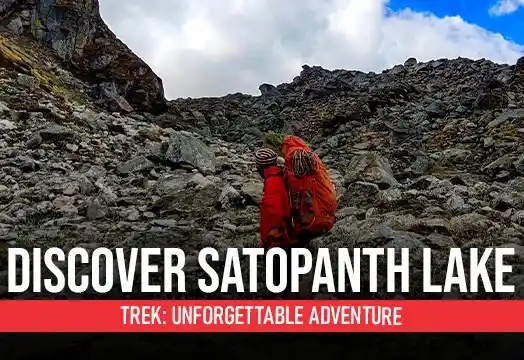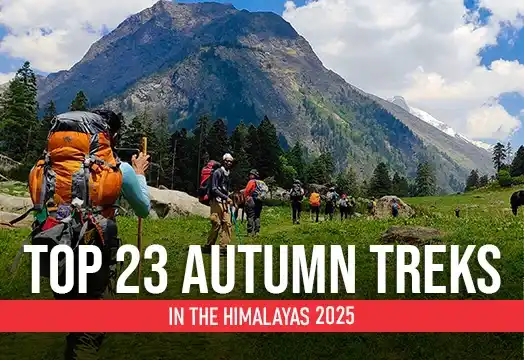Satopanth Lake Trek

Region
Uttarakhand | India

Duration
6 Days

Max Altitude
14400 Ft.

Trekking Km
40 KM

Grade
Moderate to Difficult
Get in Touch with Our Trek Expert
91 9368882322 info@trekthehimalayas.comMonday - Saturday: 10 AM to 09.30 PM (GMT +5:30)
Sunday: 10 AM to 05.30 PM (GMT +5:30)
19400 /Person
- May-2026
- September-2026
- October-2026
- 5% GST will be applicable on Trek Cost and Add-ons
- Services Pipalkoti to Pipalkoti.
- Meeting Point( Pickup/ Drop Point): Back stayz (hotel) Laxman Jhula Near SBI Bank Tapovan, Rishikesh (If transportation is opted from TTH)
- Reporting Time: 6:00 am
- Drop Time: 6:30 pm to 7:30 pm (Timings are subject to change based on weather and road conditions).
- Please reach Rishikesh a day before to avoid any delays.
Add-ons
Insurance 240
- Insurance is mandatory.
- It is available for Indian citizens only.
- Non-Indians have to take insurance on their own.
- If you already have the high altitude trekking insurance, email for a refund after booking.
- The cancellation policy will be implemented in accordance with the trek cancellation policy.
- For more details about insuranceclick here
- + 5% GST will be applicable
Transport 2500
- Transportation from Rishikesh to Pipalkoti & return is optional.
- Choose add-ons during booking. If missed, log in and add them later.
- Book transportation at least 10 days before the trek.
- Cancellation 4 or more days before the start of the trip results in a 100% cash refund.
- Cancellation less than 4 days from the start of the trip results in a 50% cash refund.
- Cancellations made on the trip date are not eligible for a refund.
- + 5% GST will be applicable
Offload 4000
- Backpack offload is optional.
- Choose add-ons during booking. If missed, log in and add them later.
- Book off-load at least 10 days before the trek.
- For offline bookings at the base camp, a convenience fee of Rs. 5000 applies.
- Cancellations made before the trip date will receive a full refund.
- + 5% GST will be applicable
Single Occupancy Tent 2800
- Single Occupancy Tent is optional.
- Choose add-ons during booking. If missed, log in and add them later.
- Book Single Occupancy Tent at least 10 days before the trek.
- Cancellations made before the trip date will receive a full refund.
- + 5% GST will be applicable
Get in Touch with Our Trek Expert
91 9368882322info@trekthehimalayas.com
Monday - Saturday: 10 AM to 06 PM (GMT +5:30)
Overview
Trek Name: Satopanth Lake Trek
Days: 6
Adventure Type: Trekking
Base Camp: Pipalkoti
Season:Summer | Autumn |
Month:May | June | October |
Country: India
Altitude: 14400 Ft.
Grade: Moderate to Difficult
Rail Head: Haridwar/Rishikesh is the nearest rail head to the base camp
Stay: Camping (Twin sharing) & Hotel/Guesthouse (Separate for male & Female)
Food: Meals while on trek & at Hotel/Guesthouse (Veg & Eggs)
Location: Uttarakhand
Distance: 40 Km.
Trail Type: Circle trail | Camping in various locations, starting and ending at the same point.
AirPort: Jolly Grant Airport, which is 21 km away from Rishikesh
Highlights:
- 5% GST will be applicable on Trek Cost and Add-ons
- Services Pipalkoti to Pipalkoti.
- Meeting Point( Pickup/ Drop Point): Back stayz (hotel) Laxman Jhula Near SBI Bank Tapovan, Rishikesh (If transportation is opted from TTH)
- Reporting Time: 6:00 am
- Drop Time: 6:30 pm to 7:30 pm (Timings are subject to change based on weather and road conditions).
- Please reach Rishikesh a day before to avoid any delays.
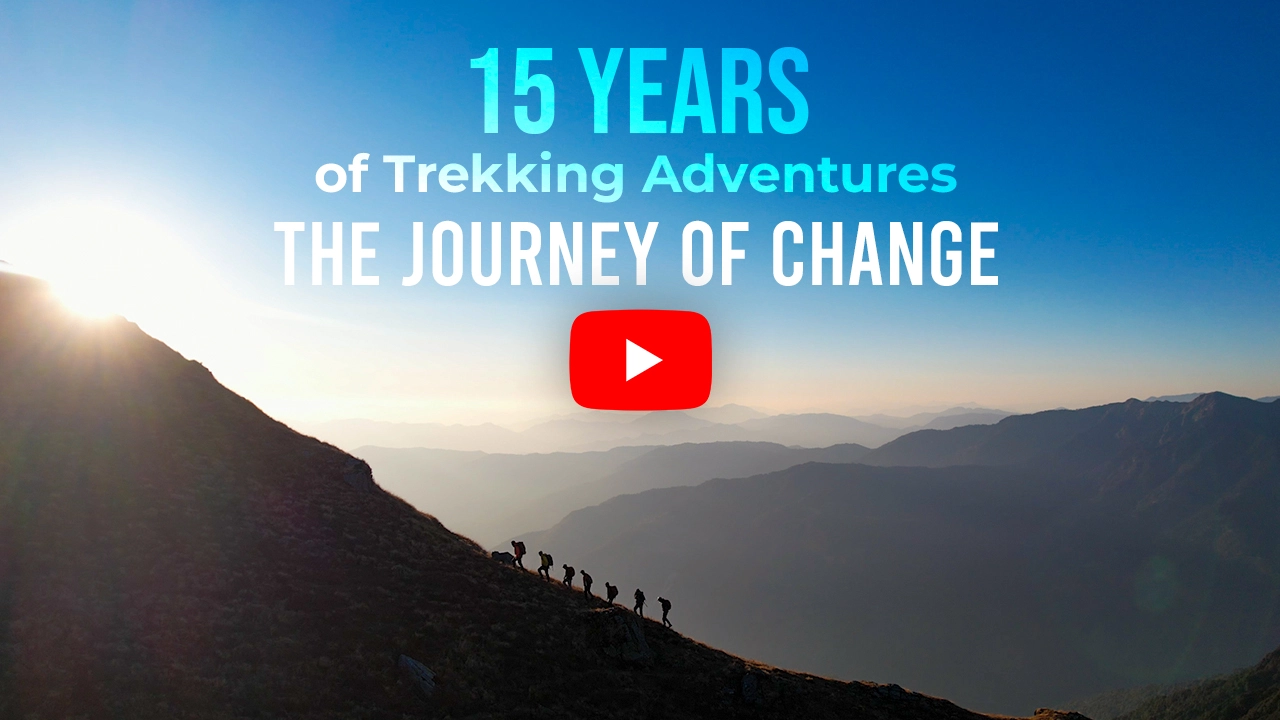
Why is Satopanth Lake Trek a Must-Do?
- Satopanth Trek takes you to Satopanth Lake, a glacial lake with a unique triangular shape. Its crystal-clear waters and mystical aura make it a beautiful and must visit destination.
- Along the trail, you will discover Sahastradhara, Vasudhara falls, and lush meadows like Lakshmi Van, each offering you a new experience.
- This trek offers you spectacular views of iconic Himalayan peaks like Chaukhamba, Avalanche, Neelkanth and Balakun that provide incredible photography opportunities.
- The Satopanth Lake trek is fondly known as the “doorway to heaven” and the beauty of this place actually justifies it.
- Starting from the sacred town of Badrinath and passing through Mana, India’s first village, the trek is a cultural immersion into Himalayan life and traditions. Each step on the trail is enriched with stories and legends.
- All through the journey, you will trek through picturesque locations with cascading waterfalls, gushing streams and vast mountains.
- The trek takes you through diverse terrains, from well made trails at the beginning to steep ascents and rocky terrains with boulders around. You would also pass through beautiful high-altitude meadows.
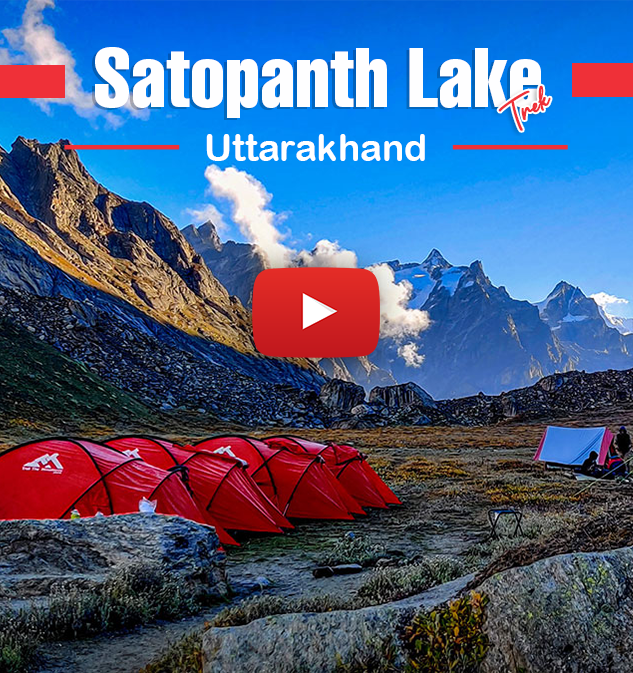
Who Can Participate
- Age Requirement:
- Minimum 14 years
- First-timers are welcome, though prior trekking experience is preferred. Good fitness is a must.
- Fitness Criteria:
- If the trekker wants to carry a backpack then he/she should be able to carry a 10-12 kg backpack. If opt Off-load option then the trekker should be able to carry 3-5 kg backpack.
- If a trekker's BMI is more or less than the normal range (18-27), please consult our Trek Coordinator before booking.
Satopanth Lake Trek Itinerary
Drive From Rishikesh To Pipalkoti
This is the first day of your journey and it commences from Rishikesh. Our representatives will pick you up from Rishikesh and drive you all the way to Pipalkoti. The journey takes you on a picturesque ride alongside the Bhagirathi River. Pipalkoti is about 200 km away from Rishikesh and it takes about 9 to 10 hrs to reach Badrinath depending on the weather and road conditions. Along the way, you also get to see the confluence of the rivers Alaknanda and Bhagirathi which merge together at Devprayag and flow as one in the form of Ganga.
On reaching Pipalkoti, we will check into a hotel and rest for the night giving the body enough time to acclimatize to the high altitude. You can take a preventive course of Diamox to help your body acclimatize faster to the higher altitudes.
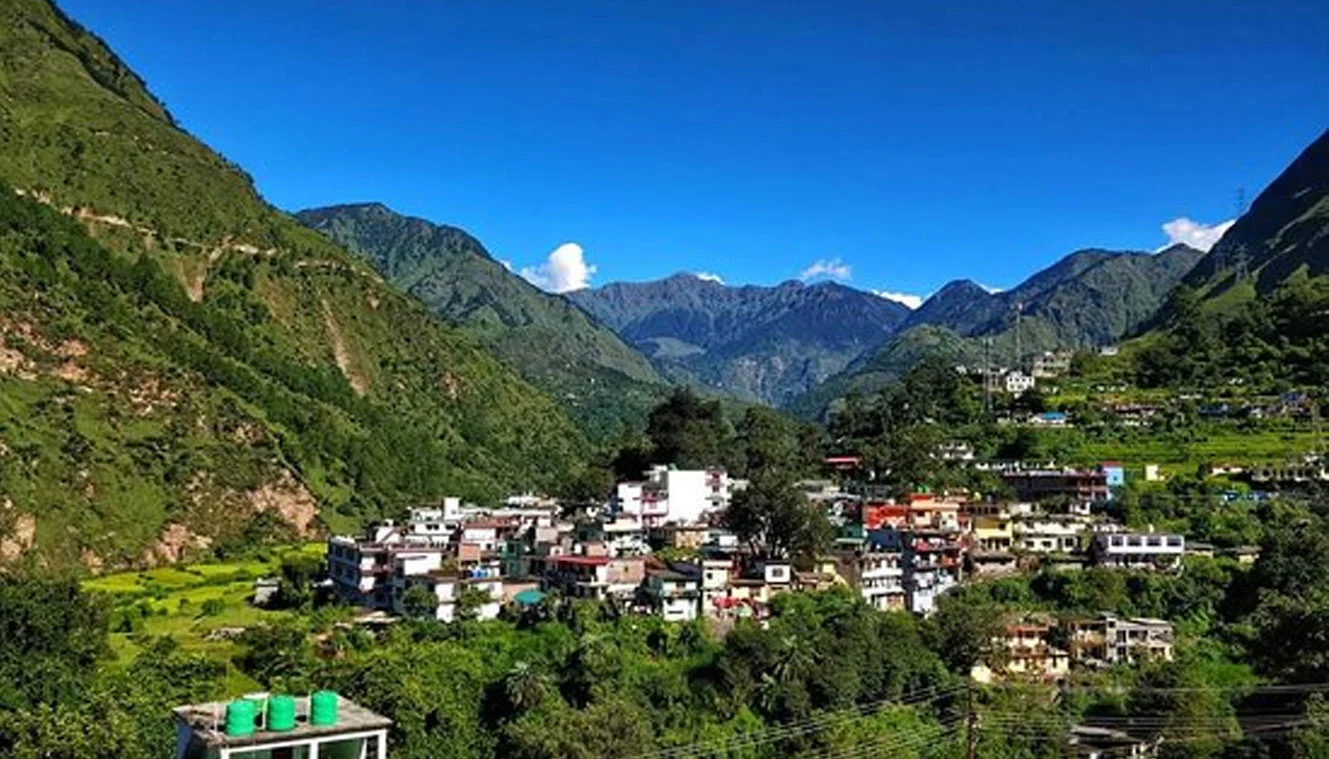
Drive to Mana via Badrinath and trek to Lakshmi Van
We will start the trek early in the morning as we have to drive a distance of 80 km today to mana. From mana, it is 7-8 km to Lakshmi Van. Mana is considered the last village in India and lies 26 km from the Indo-China border. You can also spot the road that goes to the border, although it is restricted only to people belonging to the army. Here you will have your permit checked before you continue on towards Laxmi Van. From Mana village, you will spot a trail that deviates towards the left of the Alaknanda River and for 2 to 3 km the trail is well-paved. About 3 km from the village lies the Vasundhara Falls, a 400 ft waterfall cascading down in white sheets of water. Vasundhara falls is a popular spot among tourists. The locals believe that the water of the falls as well as the Alaknanda River has medicinal value and many people store water from these water sources.
You can fill your water bottles from the waterfall. Keep hydrated as you will slowly gain altitude. After you cross the waterfall continue on the left bank of the river. You will now walk on moraines for the next 3 hrs and soon you will reach the Laxmi Van campsite. Laxmi Van campsite is located at an altitude of 11,900 ft and is covered with green and well-shaded by Bhoj Patra trees. From the campsite, you can see the Alkapuri Glacier, the source of the Alaknanda River. The glacier is situated at the base of the Balakun peak and you can witness the river flowing from the snout of the glacier. Overnight stay will be in tents.
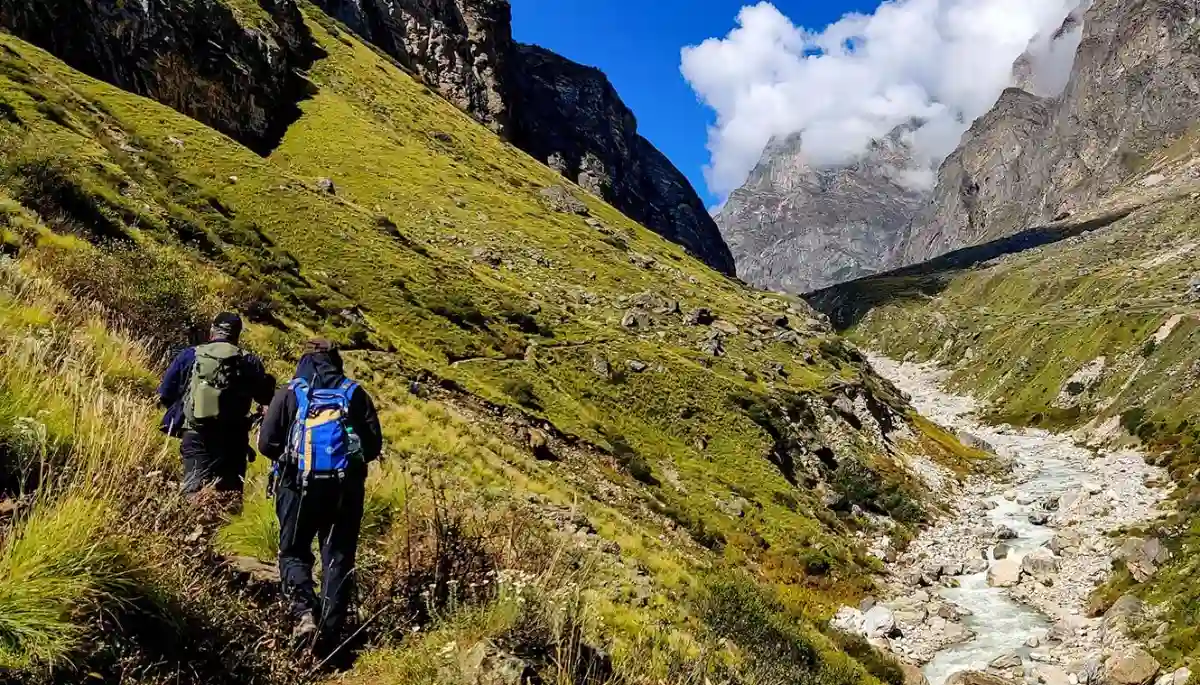
Lakshmi Van To Chakrateertha
Today’s trek is slightly more difficult than the previous day as you will gain more than 2000 ft of altitude. Even though the route is difficult but it becomes quite scenic as you enter the Satopanth Valley. The trail again follows the bank of the Alaknanda River and we will walk on a patch of grassland passing along the middle of the terminal moraine of Dhano Glacier. Once you cross this patch, the view of Bhagirathi peaks begins to open up in front of you. Although the peaks are visible only if the weather is clear.
Trekking for about 5 km, you will reach another gorgeous waterfall called Shastradhara and from here you can spot Mt. Neelkanth on your left. Shasatradhara is a culmination of more than 100 small waterfalls, streaming down a huge monolith. Weather can be quite unpredictable here post noon so we will try to begin our trek as early as possible. Chakrateertha Campsite is about half an hour away from this spot.
The campsite lies on a flat patch of a clearing. This is where we will pitch our tents for the night. Make sure you have enough warm layers on and cover your head properly. The temperature here during the daytime is 5°C to 10°C and at night it can stoop down to 0°C to -5°C. It is also important to check signs of altitude sickness at this altitude. If you are showing signs like headache, nausea, loss of appetite, fatigue, or dizziness then you should report to the Trek Leader immediately. Tonight we will camp amidst greenery and towering peaks.
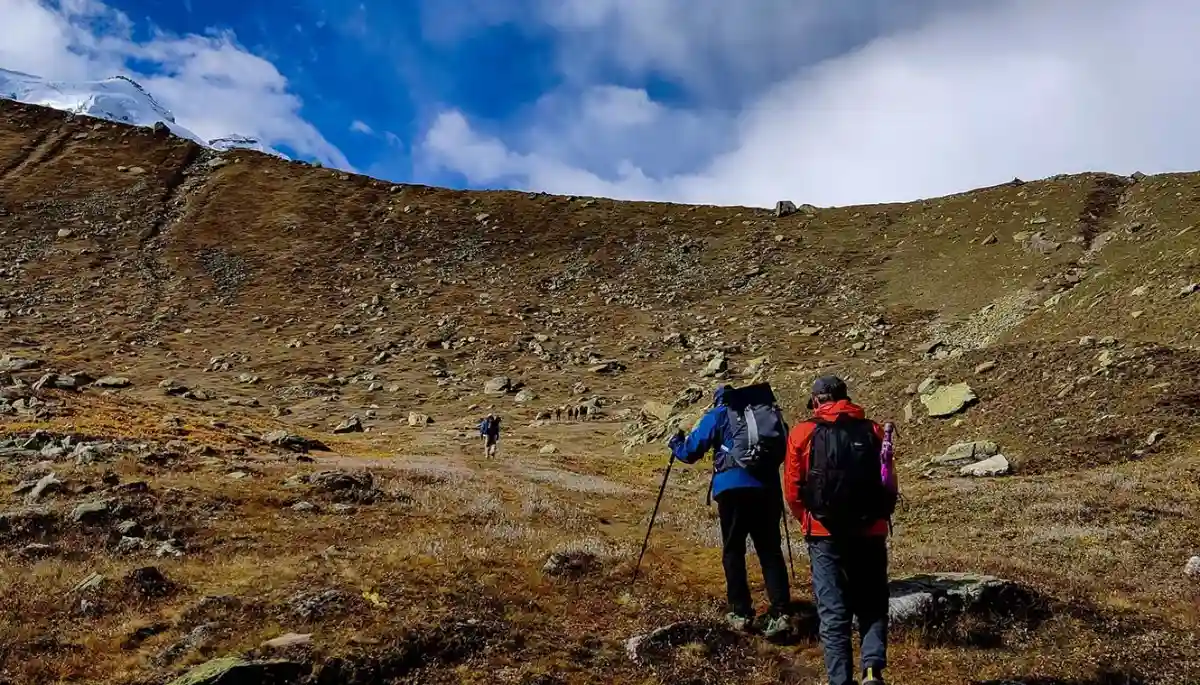
Chakrateertha To Satopanth Tal And Back
Today is one of the most exciting as well as the scenic day of the trek. Today you will trek to the mystical Satopanth Lake. Wake up to a wonderful mountain view with Mt. Chaukhamba in the center, Mt. Nelekanth on the left, and Mt. Balakun on the right. This view will stay in your mind for a long time.
The trek starts with an easy gradient as you walk on a flat grassland and after about 2 km the trek snakes around boulders and moraines. This can be a tricky section and you need to be very cautious as you navigate around this zone. Trekking poles can be of good help here.
Continue walking on the ridge, Satopanth Tal isn’t visible until you reach the top of the ridge. With a perimeter of over 1 km, the lake is simply huge. It is triangular in shape and as the legends go, it is believed that the trinity Brahma, Vishnu, and Mahesh meditated on the three corners of the lake. You can also see a small shelter made of stone near the lake. A local sage by the name of Mauni Baba is said to live here.
The lake is bluish in color and an interesting fact about Satopanth Lake is that the water of the lake remains clear all year round. Also on a clear day, you can see three out of the seven steps of the Swargarohini Glacier. It is believed that the Pandavas followed these steps to ascend into heaven.
Sit around the lake, admire its beauty and enjoy its serenity for some time before you make your way back to the Chakrateertaha Campsite. It takes about 2 to 3 hrs to descend down to the campsite from the lake.
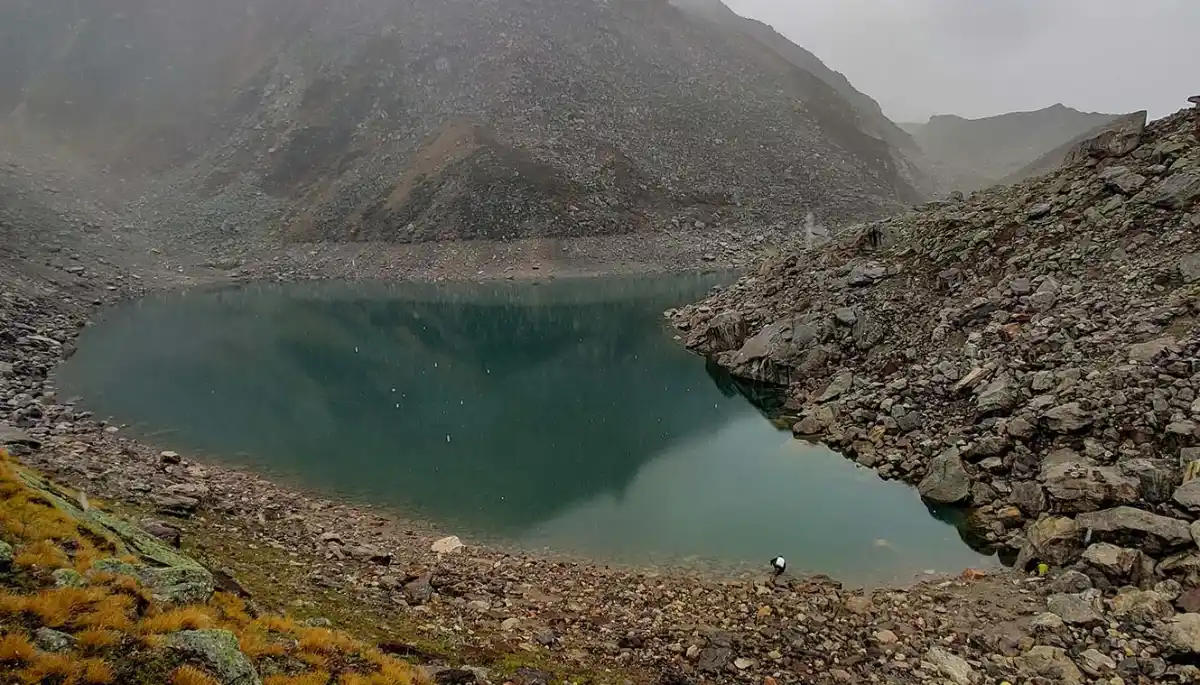
Chakrateertha To Mana and drive to Badrinath
Today is the last day of trekking in the mountains and we will be descending down to Badrinath today. It is a long walk of 15 km from Chakrateertha to Badrinath and will take about 5 to 6 hrs. We need to start as early as possible so that we can cover the long distance comfortably.
Post breakfast, we will start on our trek. From Chakrateertha, we will take the same route that we came in. We will first descend to Laxmi Van and then to Mana followed by a gentle walk to Badrinath. At Badrinath, we will check into a hotel. In the evening, you can roam around the market, and visit the Badrinath Temple. There’s also a hot water spring in Badrinath, where you can take a dip.
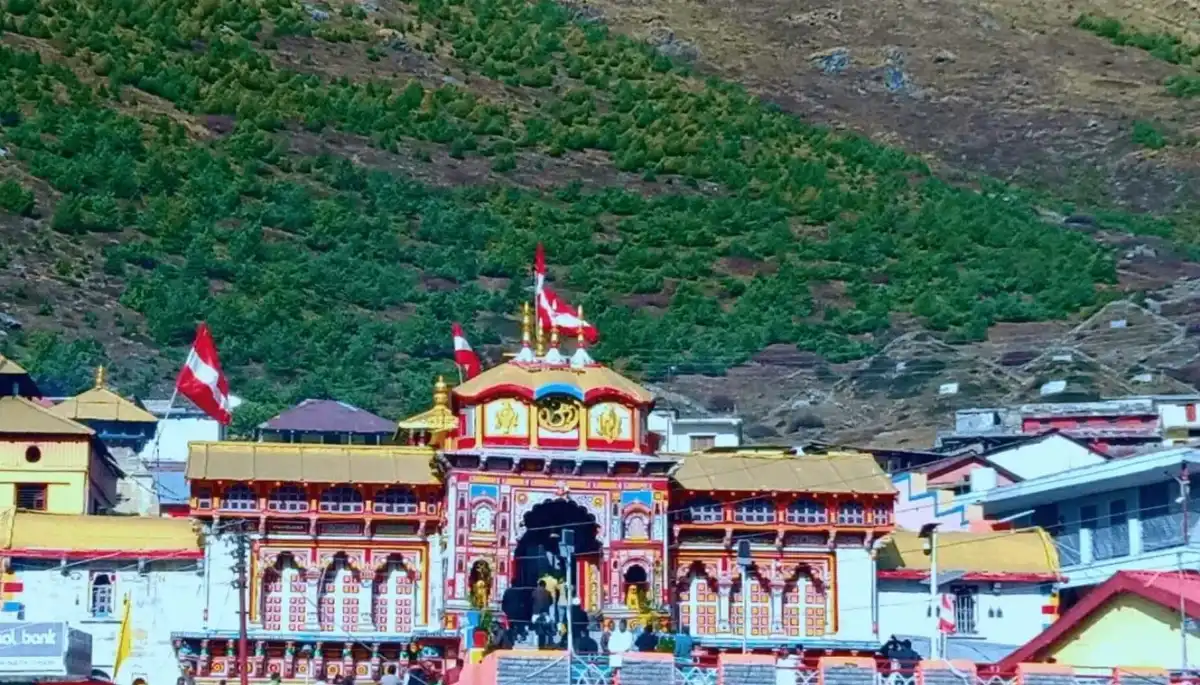
Badrinath To Rishikesh
The beautiful time in the mountains ends today as you will be driven back to Rishikesh. Wake up early and have a delicious breakfast post which we will start our drive towards Rishikesh.
The drive will be along the same scenic routes where you can reminisce about your journey. It will take 9 to 10 hrs approximately to reach Rishikesh. You can expect to reach Rishikesh by 7 PM.
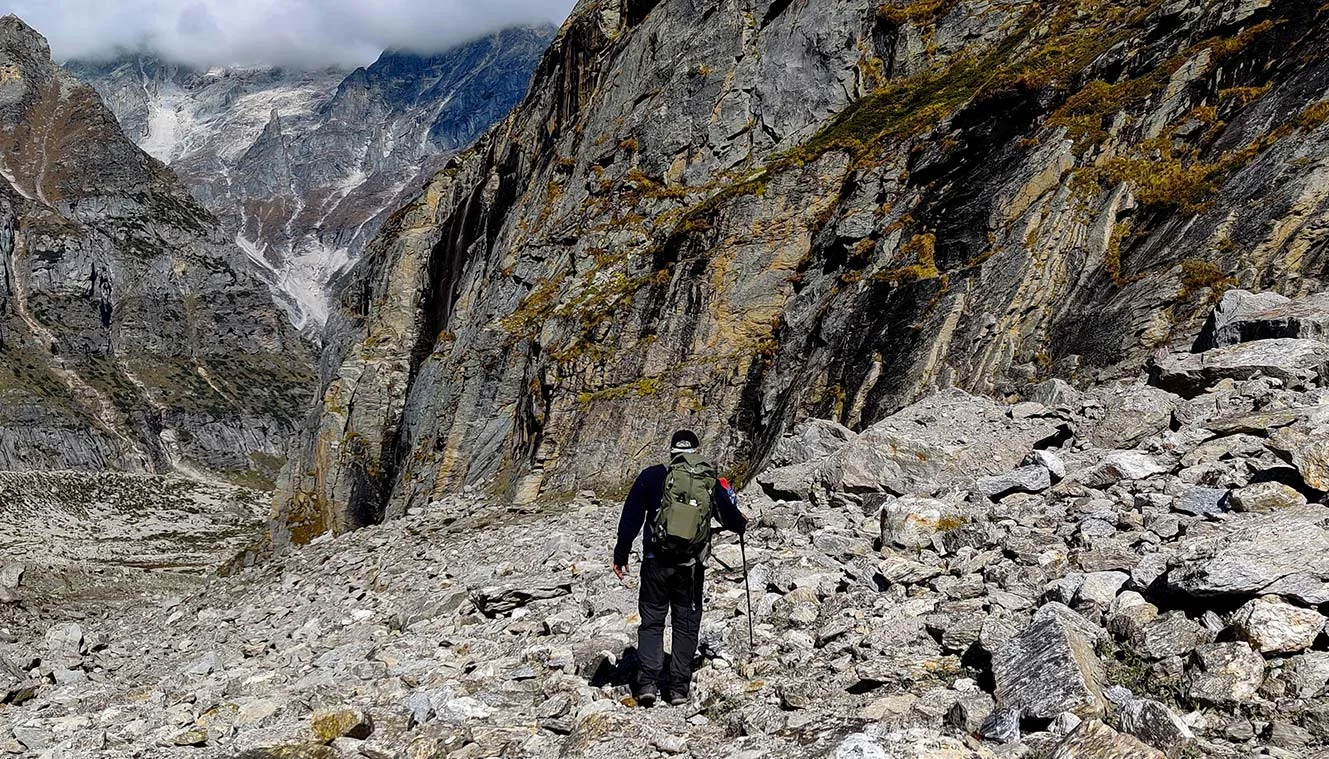
Day-1: Drive From Rishikesh To Pipalkoti
- Altitude: 1,500m/4,950ft.
- 200 km drive, approx 10 hours.
- Trekkers will be picked from Rishikesh TTH office at 6:00am in a Tata Sumo or a similar vehicle (cost is not included).
- Arrive at Pipalkoti approx by 5 pm – (tea, briefing of the trek & dinner).
- Breakfast and Lunch on the way (exclusive of charges).
- Accommodation at the guest house.
- Telephone Network- Available.
- Transportation is not included in the cost.
Day-2: Drive to Mana via Badrinath and trek to Lakshmi Van
- Altitude: 11,900 ft.
- Drive Distance (Pipalkoti to Mana): 80km
- Drive Time: 3-4 hrs
- Trek Distance: 7-8 km.
- Duration: 5-6 hrs.
- Witness the 400 ft tall Vasundhara Falls.
- Sight the Alkapuri Glacier from where Alaknanda originates.
- Stay in tents (twin-sharing).
Day-3: Lakshmi Van To Chakrateertha
- Altitude: 13,658 ft.
- Trek Distance: 7 km.
- Trek Duration: 5-6hrs.
- Stay in tents (twin-sharing).
Day-4: Chakrateertha To Satopanth Tal And Back
- Altitude: 14,258 ft.
- Trek Distance: 10 km (5 km on each side).
- Trek Duration: 8 hrs.
- Stay in tents (twin-sharing).
Day-5: Chakrateertha To Mana and drive to Badrinath
- Altitude(Badrinath ): 10,830 ft.
- Trek Distance: 15 km.
- Trek Duration: 5-6 hrs.
- Drive Distance: 5 km.
- Drive Time: 10 min.
- Stay in the hotel.
Day-6: Badrinath To Rishikesh
- Drive: 290 km, approx 10-11 hrs.
- Ride will commence at 6 am, reaching the destination at around 6 pm.
- Breakfast and Lunch will be on the way at a roadside inn, exclusive of charges.
- Return transportation is not included.
Note:
- Keep a buffer day in your travel plan.
- If buffer day is not used in the travel then it can be used to Explore Rishikesh.
- Read the article Things to do in Rishikesh.
- Distance, Altitude, and Trekking hours are approximate and rounded off.
- Keep the original and copy of ID proof handy.
- Come one day early if planning to come by plane.
Satopanth Lake Trek Graph
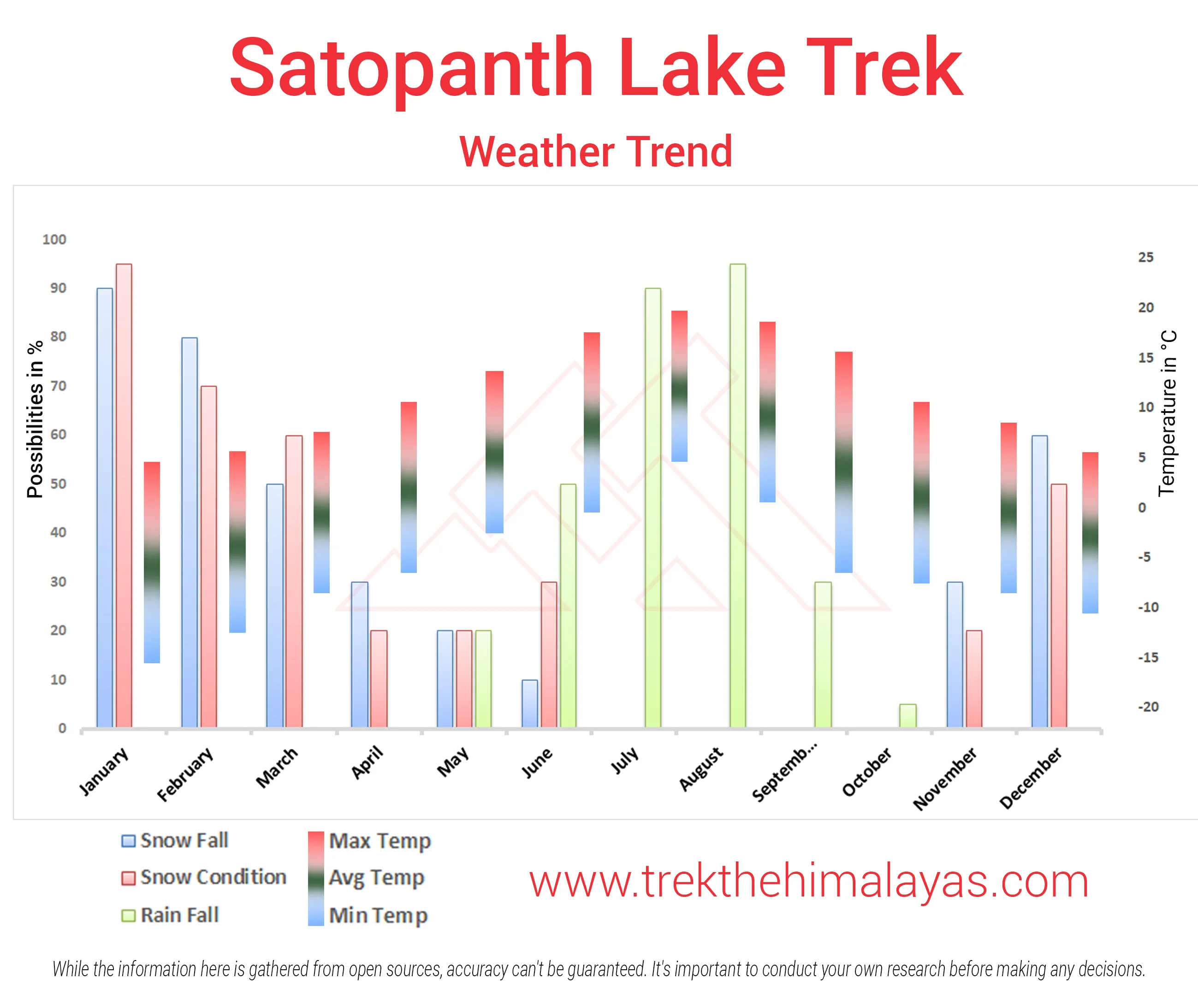
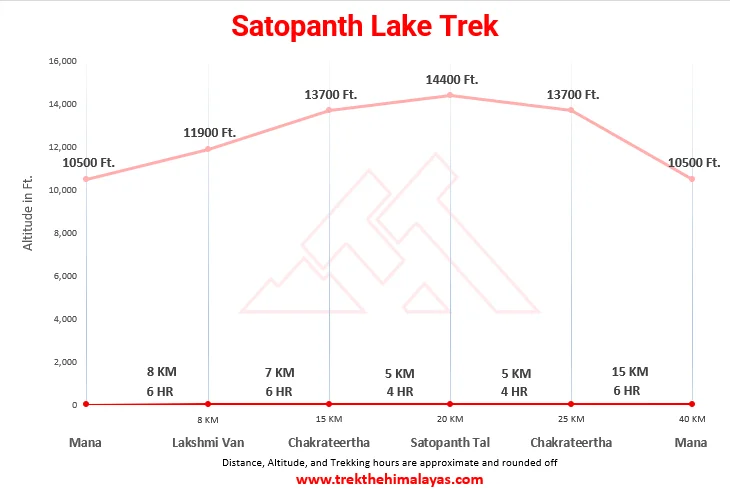
_11zon.webp)
- Pulse rate at rest must be in between (60 to 100 beats per minute).
- Blood Pressure Reading must be in between (DIASTOLIC 75 – 85, SYSTOLIC 100 - 130 mm Hg).
- Respiratory rate at rest must be in between (12 to 20 breaths per minute).
- Should not have Liver and kidney issues.
- Should not have Diabetes Mellitus, Bronchial Asthma, Heart problems, Hypertension, etc.
- No pacemaker implant.
- People with Sinus issues, Epilepsy please contact to trek coordinator before booking the trek.
- If your BMI is not normal, Please contact our Trek coordinator before Trek booking.
Medical & Disclaimer Form (Mandatory Documents) Click here to download Medical & Disclaimer Form
Government employees can avail the benefit of Special Casual Leave (SCL) when they join us for a trekking expedition. As per Pay Commission guidelines, up to 30 days of Special Casual Leave can be availed in a calendar year for trekking or mountaineering expeditions conducted through a registered organisation.
Trek The Himalayas is a registered adventure tour operator with the Indian Mountaineering Foundation (IMF) and the Ministry of Tourism (MoT), making your trek eligible for SCL benefits.
To apply, email us at info@trekthehimalayas at least 20 days before the trek departure date, with the following details:
- Trek name and trek date
- Booking details
- Full name
- Designation
- Department and department address
This benefit is exclusive to Indian Government employees and is applicable only for treks within India.
- Junior trekkers (below 15 years) should have a company of parents/guardians.
- Trekkers between 15 to 18 years can come solo with the disclaimer form signed by parent/guardian.
- Medical & Disclaimer Form (Mandatory Documents) Click here to download Medical & Disclaimer Form
Important Links
- Mandatory Documents to Bring on A Trek Click Here.
- How to pay Add-ons, Submit Medical Forms, and Dietary Preferences Click Here to watch Video
How To Reach
Pick-Up Information
- It is essential for everyone to arrive at Rishikesh (06:00 am)
- Pick-up Location - Back Stayz Laxman Jhula Near SBI Bank Tapovan
- Once you have reached Rishikesh, TTH will manage the rest of your travel arrangements, if you have opted for TTH's pick-up service, you can select this option during the booking process by adding it as an add-on.
Options to Reach Rishikesh
First, you can arrive at Delhi, Dehradun airport or Chandigarh. The journey from these locations to Rishikesh is explained below.
1. Take overnight train/bus to Rishikesh.
2. Take overnight train/bus to Haridwar and drive to Rishikesh (25km | 35 min drive with normal traffic).
3. Take overnight train/bus to Dehradun and drive to Rishikesh (50km | 1hr 20min drive with normal traffic).
( We always recommend going for the govt. Buses over the private ones outside the bus station as based on the experience we have found that there are very high chances of delay involved with private buses. Also, govt. Buses are always more reliable. Whichever bus you choose, just make sure to reach Rishikesh at least by 05:30 am. )
4. Board a flight to Dehradun airport (Jolly Grant Airport) (21 km, 30 min). If you're arriving by air, then come one day in advance.
Drop-Off Information
- The designated drop-off point is Tapovan, Rishikesh.
- Reach in Rishikesh by 6:30 to 7:30 pm.
- Please consider planning your subsequent travel arrangements after 10:00 pm.
Note - In July and August month always have a buffer day in your Itinerary due to the Monsoon.
- It's highly advisable to keep a buffer day in your travel plan. If the buffer day is not used, it can be used to explore Rishikesh.
( If you prefer to travel independently to Base camp and don't want to take TTH's pick-up service, you can either take a government bus or book a private cab from Rishikesh. Your trek coordinator will provide guidance on how to arrange for the bus or cab booking. )
- TTH offers comfortable transportation through Tempo Traveler, Bolero, or equivalent vehicles. If you wish to upgrade your mode of transportation, please contact your trek coordinator for further assistance.
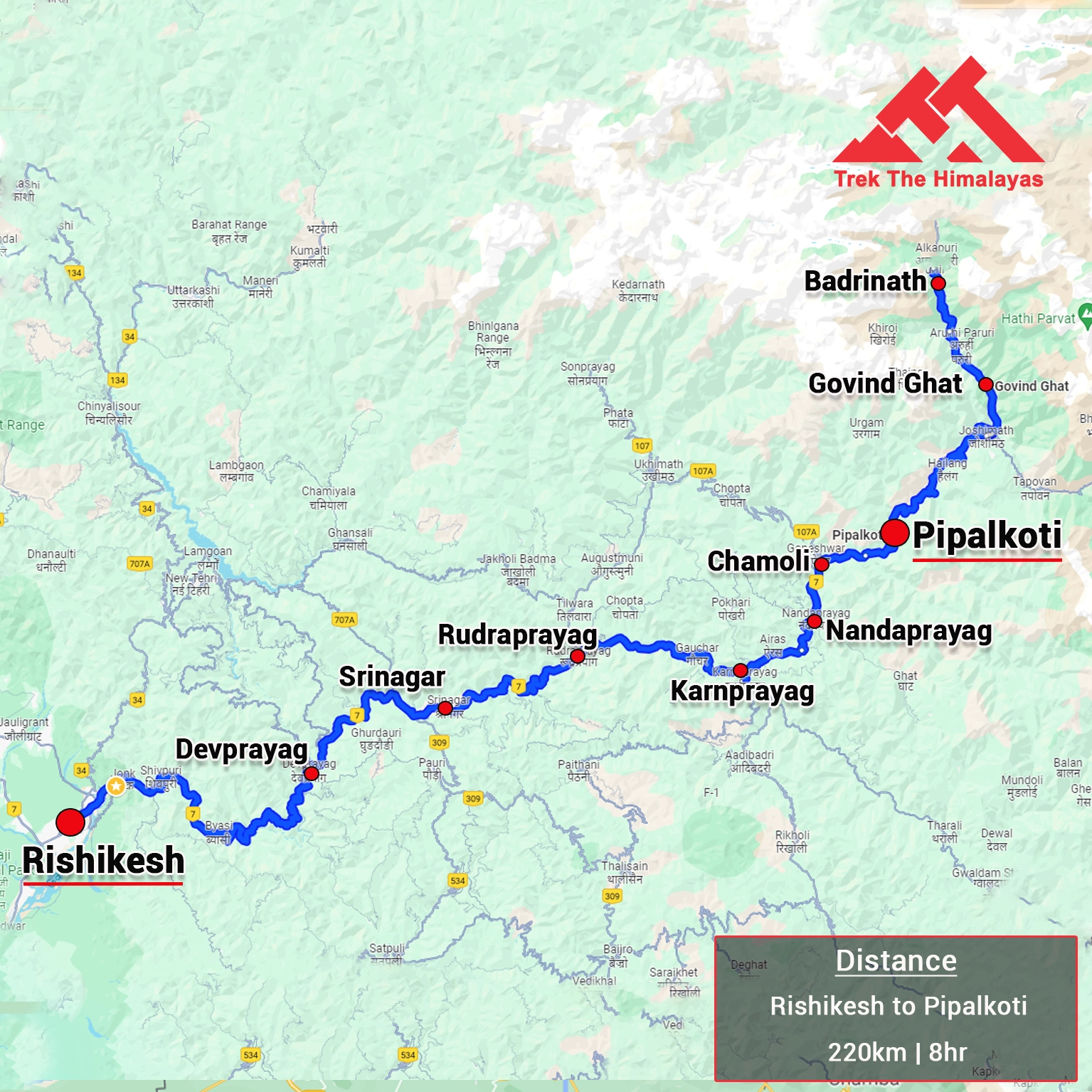
Cost Terms
Inclusion
1. Accommodation (as per the itinerary):
- Guest house in Pipalkoti (Day 1 and Day 2 as per the itinerary).
- Camping while on trek (twin sharing).
2. Meals (Veg + Egg):
- All meals (including tea, soup, snacks, etc.) from Day 1 Dinner to Day 5 Dinner.
3. Support:
- 1 Versatile base camp manager: handles communication and deploys extra manpower in emergencies.
- 1 Mountaineering & First aid qualified professional trek Leader.
- 1 Experienced high altitude chef.
- Local experienced guides (Number of guides depending on the group size).
- Enough support staff.
4. Trek equipment:
- Sleeping bag, Sleeping liners (if required), Mattress, Utensils.
- 3 men all season trekker tent (twin sharing), Kitchen & Dining tent, Toilet tent.
- Camping stool, Walkie talkie.
- Ropes, Helmet, Ice axe, Harness, Gaiters & Crampon (if required).
5. First aid:
- Medical kit, Stretcher, Oxygen cylinder, Blood pressure monitor, Oximeter, Stethoscope.
6. Transportation (as per the itinerary):
- Rishikesh to Pipalkoti & return.
7. Mules/porters to carry the central luggage.
8. Cloakroom facility available at the base camp for additional luggage.
9. All necessary permits and entry fees, Upto the amount charged for Indian.
10. Services from Pipalkoti to Pipalkoti.
11. Trek Completion Certificate.
Exclusion
- Insurance (For non-Indian Nationals, NRI or OCI card holders).
- Food during the transit.
- Any kind of personal expenses.
- Mule or porter to carry personal luggage.
- Emergency evacuation, hospitalization charge, etc.
- Any extra costs incurred due to extension/change of the itinerary due to natural calamities roadblocks, vehicle breakdown, etc. factors beyond our control
- Anything not specifically mentioned under the head Inclusion.
Things can be provided on demand and availability (participant has to pay extra for these things).
1- Satellite phone/set phone - is a type of mobile phone that connects via radio links via satellites orbiting the Earth instead of terrestrial cell sites like cellphones. Therefore, they can operate in most geographic locations on the Earth's surface.
2- Gamow/PAC HAPO Bag (Portable Hyperbaric Bag) - is a unique, portable hyperbaric chamber for the treatment of acute mountain sickness (AMS), also known as altitude sickness.
3- AEDs (Automated External Defibrillators) - are portable life-saving devices designed to treat people experiencing sudden cardiac arrest, a medical condition in which the heart stops beating suddenly and unexpectedly.
Cancellation Terms
To request a cancellation, please email us at info@trekthehimalayas.com using your registered email ID.
Cancellations prior to 25 days from the start of the Trip
Refund Options
- 5% deduction of trek fee
- 100% trek fee cash voucher for any trip till one year
- Transfer your trek (any trek, any date) to your friend
Cancellation between 24 days and 15 days to the start of the Trip
Refund Options
- 30% deduction of trek fee
- 100% trek fee cash voucher for same trip till one year
- 85% trek fee cash voucher for any trip till one year
- Transfer your trek (same trek, any date) to your friend
Cancellation between 14 days and 10 days to the start of the Trip
Refund Options
- 50% deduction of trek fee
- 80% trek fee cash voucher for same trip till one year
- 70% trek fee cash voucher for any trip till one year
- Book the same trek, in the same season, with any other batch
- Transfer your trek (same trek, any date) to your friend
Cancellation less than 9 days to the start of the trek.
Refund Options
- No cash refund
- 20% trek fee cash voucher for the same trip till one year
- 10% trek fee cash voucher for any trip till one year
- Transfer your trek (same trek, same date) to your friend
- To reschedule a trek (same trek only), a 30 % rescheduling fee of the trek cost will apply.
Cancellation Policy (Emergency Cases):
In case of a death in the immediate family (parents, siblings, spouse, children) or if the trekker is hospitalized (min. 48 hours) or suffers a fracture (leg/arm) within a week before the trek, even if canceled a day before:
90% trek fee refund in cash & 10% as a voucher (valid for 1 year, for any India trek).
Valid documents required. We’re here to support you during tough times.
Note:
- Change of trek batch is dependent on the availability of seats in the batch
- In case of transferring a trek to a friend, he/she should satisfy all the mandatory requirements put forward by TTH
- TTH holds the right to change/cancel the policies, without prior notice
Booking and Payments
- The Participant is responsible for verifying the accuracy of all details, including Trip dates and personal documentation, at the time of booking.
- Payments must be made in accordance with the timelines and instructions provided by TTH. Late payments may result in cancellation of booking without refund.
- In the event of a cash refund, only the portion of the payment made in cash shall be eligible for refund in cash. Any booking made using voucher, discounts, promotional codes, or through any non-cash mode of payment shall not be eligible for a cash refund under any circumstances.
- Refunds, if applicable, shall be processed within 15–30 working days of confirmation.
- All add-on bookings are subject to the respective add-on cancellation policy, and refunds will be processed accordingly.
- Voucher Terms
- This is a non-transferable voucher
- The voucher cannot be merged with any other offer of Trek The Himalayas
- The voucher is valid for Trek booked directly with Trek The Himalayas in India
- To avail the voucher please use your register phone number or e-mail id
- All the other Terms of booking a trek with Trek The Himalayas are applicable to the voucher
Itinerary and Modifications
- TTH reserves the right to modify, shorten, or cancel any part of the Trip due to transportation delays, weather, health emergencies, or other unforeseen circumstances including Force Majeure.
Cancellations and Refunds
- No refunds or vouchers, partial or otherwise, shall be provided for voluntary withdrawal, non-utilisation of services, or removal from the Trip.
- If TTH cancels the Trip before arrival at the designated pick-up point due to unforeseen circumstances or Force Majeure, the Participant may choose from:
- An alternate Trip/date.
- A credit voucher valid for one (1) year.
- Transfer to another Trip, with cost differences payable by the Participant.
- If the Trip is abandoned post-arrival at the designated pick-up point, no cash refund or voucher shall be issued. The Trek Again Policy may apply at TTH’s discretion.
- TTH shall not be liable for any associated travel costs such as flights, accommodation, or visa fees.
Force Majeure
- Events beyond its control including but not limited to earthquakes, landslides, strikes, curfews, war, pandemic, government restrictions, heavy rainfall or snowfall, windstorms, road blockages, trail disruption, or withdrawal of permits, TTH shall not be held liable for any cancellation, delay, or service modification caused by Force Majeure.
Trek Essentials
Rent EquipmentPDF Of Trek Essential Download
| Backpack with rain cover | (50 - 60 ltr) with comfortable shoulder straps |
| Day pack with rain cover | 20 - 30 ltr (If off-load opted) |
| Walking stick | Advisable (At least one) |
| Water Bottle / Hydration pack | 2 bottles of one liter each, People who use hydration pack 1 hydration pack and 1 bottle of one liter, Carry at least one thermos flask. |
| Small size tiffin/lunch box | 1 Nos |
| Snacks | Energy bars, dry fruits, electral/ors |
| Personal Medical Kit | Consult your doctor |
| T-Shirt (Synthetic quick dry) | 1 Full & 2 Half sleeves |
| Fleece T-shirt | 1 Nos |
| Wind stopper / Fleece jacket | 1 Nos |
| Windproof Jacket | 1 Nos |
| Down feather / Hollow jacket | 1 Nos |
| Thermal inner (Upper and Lower) | 1 Pair |
| Trek Pant (Synthetic quick dry) | 2 Nos |
| Wind stopper / Fleece Pant | 1 Nos |
| Waterproof gloves | 1 Pair |
| Fleece / woollen gloves | 1 Pair |
| Poncho / waterproof Jacket and pant | 1 Nos |
| Sunscreen | 1 Nos |
| Moisturiser | 1 Nos |
| Chap-stick / Lip balm | 1 Nos |
| Toothbrush and toothpaste | 1 Nos |
| Toilet paper & Wipes | 1 Nos |
| Soap / hand sanitizers | 1 Nos |
| Antibacterial powder | 1 Nos |
| Quick dry towel | 1 Nos |
| Head torch | 1 Nos. (Avoid Hand torch) |
| Sun Cap | 1 Nos |
| Woolen cap | 1 Nos. |
| Balaclava | 1 Nos. |
| Buff / Neck-gaiters | 1 Synthetic & 1 Woollen |
| Sunglasses | UV with dark side cover, People who wear spectacles - (A)- Use contact lenses | (B)- Photo chromatic glasses |
| Trekking shoes | 1 Pair (Water-resistant, high ankle, good grip) |
| Floaters / flip-flops | 1 Pair |
| Cotton socks | 6 pairs |
| Woollen socks | 1 pairs |
| Gaiters | 1 Pair (TTH provides when required) |
| Micro spikes | 1 Pair (TTH provides when required) |
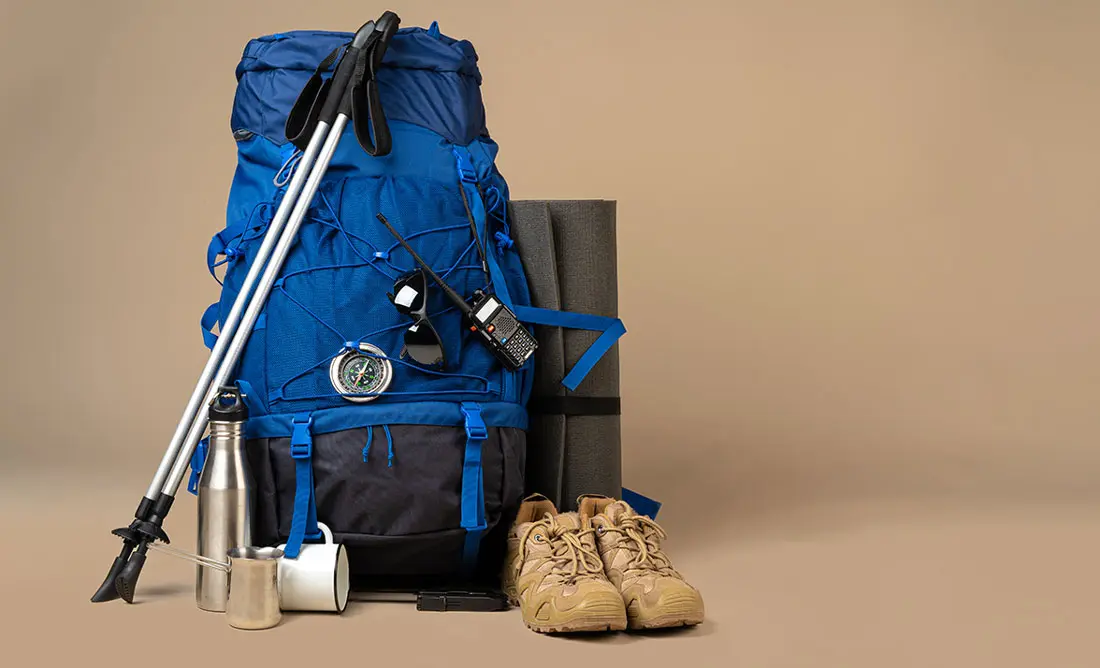
Frequently Asked Questions(FAQ)
To register with TTH, visit our website - www.trekthehimalayas.com and create your account. To create your account you will need to use your email address and fill in all the details, set your unique password and your account is ready to use.
- To book a trek with TTH, you first need to register with us and create an account.
- Choose the trek that you want to do and click on available dates.
- You will land at the login page, fill in the required details.
- Add Participants, choose add-on services click on the Pay now button, choose your preferred payment method, and make the payment. TTH accepts multiple payment options, including credit/debit cards, net banking, and UPI.
- You will receive a confirmation email from TTH with all the necessary details about the trek, including the meeting point, transportation, accommodation, and other important instructions.
- Click Here to watch Video
please send an email to us at info@trekthehimalayas.com or reach out to the numbers provided in the Help and Support section of your Trek Page. We will ensure that your issue is promptly resolved.
To book services such as off-load luggage and transportation, you can find them listed as add-ons. These additional services can be booked at the time of your initial booking. If you miss booking add-ons during the initial reservation, you can log in anytime and easily book 4 days before the departure date add-ons through the platform.
If you have booked the wrong trek or selected the wrong date, don’t worry! You can contact us at +91 9368882322 (Monday to Saturday, 10 AM to 10 PM) or email us at info@trekthehimalayas.com. You can also discuss this with your trek coordinator. Please make sure to inform us at least 10 days before the departure of your trek. Only then can we help you reschedule or arrange another trek for you.
We recommend visiting our "Suggest Me a Trek" page. By filling out the form, our experts will contact you with the best possible trek options based on your preferences and experience level. Alternatively, you can reach out to us via email at info@trekthehimalayas.com or give us a call using the numbers provided on our website for personalized assistance and recommendations.
Family treks differ from regular treks by focusing on ease of difficulty, offering shorter durations for younger participants, Kid-friendly and easily digestible foods, child-friendly activities, maintaining a higher guide ratio for diverse age groups, and implementing additional safety measures for families.
Family Trek with Kids recommendation Only Dayara Bugyal and Chopta Chandrashila Trek.
Minimum age for TTH treks is typically 7 years, though this may vary depending on the specific trek.
Yes, you can take a kids to a high-altitude trek with a parent. Discuss with a trek expert before booking a trek.
- Junior trekkers (below 15 years) should have a company of parents/guardians.
- Trekkers between 15 to 18 years can come solo with the disclaimer form signed by parent/guardian.
- Medical & Disclaimer Form (Mandatory Documents) Click here to download medical and disclaimer form
Physical Fitness: Ensure your child is physically fit. Engage them in regular exercise, outdoor activities, and hikes to build stamina and endurance. Hydration: Emphasize the importance of staying hydrated at high altitudes. Encourage your child to drink water regularly, even if they don't feel thirsty. Proper Nutrition: Provide a well-balanced diet with sufficient carbohydrates for energy and foods rich in iron to prevent altitude sickness. Adequate Sleep: Ensure your child gets enough sleep in the days leading up to the trek. Quality rest is crucial for altitude adaptation. Educate on Altitude Sickness: Teach your child about the symptoms of altitude sickness, such as headache, nausea, and dizziness. Encourage them to communicate any discomfort immediately. Appropriate Clothing and Gear: Dress your child in layers to adjust to changing temperatures. Ensure they have appropriate trekking gear, including sturdy footwear. Positive Mindset: Foster a positive mindset. Encourage your child, and let them know it's okay to take breaks when needed. Medical Check-Up: Schedule a medical check-up before the trek to ensure your child is fit for high-altitude activities. Consult with a healthcare professional about any potential health concerns.
TTH takes special care to provide wholesome and nutritious food for children on treks. Here are some of the foods that are typically served for children:
Breakfast: For breakfast, TTH serves a variety of options like porridge, cornflakes, bread, butter, jam, honey, boiled eggs, omelettes, and pancakes. Children can choose from these options to fuel themselves for the day's trek.
Lunch: For lunch, TTH serves lunch which includes rotis, vegetables, rice, dal, and salad. The rotis are usually made fresh on the trek and are a good source of carbohydrates. The dal and vegetables provide protein and other essential nutrients.
Snacks: TTH provides healthy snacks like fresh fruits, dry fruits, energy bars, cookies, and biscuits to keep the children energized throughout the day.
Dinner: For dinner, TTH serves a hot and wholesome meal which includes soup, rice, dal, vegetables, and a non-vegetarian dish (if requested in advance). Children can also choose from a variety of desserts like custard, jelly, and fruit salad.
Dietary requirements: If a child has any special dietary requirements, TTH can cater to those needs as well. For example, if a child is lactose intolerant or allergic to nuts, the kitchen staff can make arrangements to accommodate those requirements.
Choosing the right trek for a beginner can be a bit overwhelming as there are many factors to consider such as distance, elevation gain, terrain difficulty, weather, and time of year. Here are some tips that can help you choose the right trek for a beginner:
1. Determine fitness level: Assess the fitness level of the beginner to understand their physical capabilities. This will help you select a trek that is challenging but not too difficult.
2. Choose a well-traveled trail: A well-traveled trail will have more amenities such as signposts, water stations, and shelter. It is also safer as there will be other hikers on the trail.
3. Consider the length of the trek: For beginners, it is recommended to start with a shorter trek that can be completed in a day or two. This will help them get acclimatized to trekking and build their confidence.
4. Look for gradual elevation gain: Choose a trek with a gradual elevation gain rather than steep ascents. This will make the trek easier and more enjoyable.
5. Check the weather: Check the weather forecast before selecting a trek. Avoid treks during the monsoon season or winter when the trails can be slippery or dangerous.
6. Research the trail: Read about the trail to get an idea of the terrain, altitude, and difficulty level. This will help you select a trek that is suitable for the beginner.
7. Consult with an expert: If you are unsure about which trek to choose, consult our trek expert Mr. Nitin (+91 70600 59773) between 10 AM to 6 PM (Tuesday - Friday). Mr. Nitin will provide you valuable advice and guidance.
Overall, it is important to choose a trek that is enjoyable, challenging but not too difficult, and suitable for the beginner's fitness level and experience.
It is not recommended for a beginner to choose a difficult Himalayan trek. Trekking in the Himalayas can be physically and mentally challenging, especially if you are not used to the high altitude, steep slopes, and rugged terrain. Choosing a difficult trek without the proper experience, fitness level, and preparation can be dangerous and put you at risk of altitude sickness, injury, and other hazards.
If you are a beginner, it is recommended to start with an easier trek and gradually build up your skills and experience. This will help you understand the challenges of trekking in the Himalayas, and also prepare you physically and mentally for a more difficult trek in the future. It is also important to choose a trek that matches your fitness level, experience, and interest.
There is no specific age limit for a beginner trekker. However, it is important to consider your physical fitness, health condition, and personal interests before embarking on a trek. Trekking in the Himalayas can be physically and mentally demanding, and requires a certain level of physical fitness and endurance.
If you have any pre-existing medical conditions or are above a certain age, it is recommended to consult with a doctor before embarking on a trek. It is also important to listen to your body and take breaks as needed during the trek to prevent exhaustion or injury.
We recommend visiting our "Suggest Me a Trek" page. By filling out the form, our experts will contact you with the best possible trek options based on your preferences and experience level. Alternatively, you can reach out to us via email at info@trekthehimalayas.com or give us a call using the numbers provided on our website for personalized assistance and recommendations.
Yes, you can join the trek. We have fixed departure groups where you can simply book your trek and we will take care of curating a group.
Before you start the trek, it is recommended that you make all the necessary phone calls as during the trek you may or may not receive network coverage, once you come back to the Base Camp, you can reconnect with your family via phone once again. You can share your trek coordinator contact detail with your family members to get the latest updates about your trek batch.
At TTH, we provide wholesome and nutritious meals during the trek. The food is vegetarian and includes a variety of dishes such as rice, dal, vegetables, chapati, paratha, pasta, noodles, and soup. We also offer snacks such as biscuits, and salty, and dry fruits during the trek. Special dietary requirements such as vegan, gluten-free, or Jain food can also be arranged if informed in advance.
If you are allergic to some foods, you need to let us know in advance so that we can make arrangements accordingly.
TTH is a trekking company that prioritizes the safety of all its participants, including women trekkers. We have a comprehensive safety system in place, which includes a dedicated team of experienced and trained trek leaders and support staff who are equipped to handle emergency situations and provide first aid.
TTH also takes specific measures to ensure the safety and comfort of women trekkers. They have a separate tent accommodation for women trekkers, female trek leaders, and support staff. They also provide separate toilet facilities for women and encourage a safe and respectful environment for all trekkers.
Moreover, TTH has a strict policy against any kind of harassment and has a zero-tolerance policy towards such incidents. They have a designated Internal Complaints Committee (ICC) to investigate and address any complaints related to harassment or misconduct. Overall, TTH has a good reputation for safety and responsible trekking practices, and women can feel comfortable and safe while trekking with them.
In case you are the only women in the group, we provide a single sleeping arrangement. Also, during the trek, the trek leader will always remain by your side to provide optimum safety and reassurance.
You can reach out to the trek coordinator to inquire about the number of female trekkers and their respective states who have booked the trek. Please note that the trek coordinator cannot disclose personal details of any trekker. Once you've confirmed your booking, a WhatsApp Group will be created for all the trekkers in your batch. This allows you to connect with fellow trekkers before the trek begins.
While many of our treks are led by female trek leaders, however, it is not possible to know which trek leader is assigned to which group. But nonetheless, whether the trek leader is male or female you can be completely assured of your safety and security with us.
Yes, it is possible to trek with periods. However, it is important to take some extra precautions and preparations to ensure a comfortable and safe trekking experience. Here are some tips that can help you trek during your period:
1. Use menstrual hygiene products that you are comfortable with, such as tampons, pads, or menstrual cups. It is recommended to carry enough supplies for the entire duration of the trek.
2. Pack wet wipes, hand sanitizer, and plastic bags to dispose of used hygiene products.
3. Wear comfortable and breathable clothing that allows for easy movement and reduces friction. Avoid wearing tight or restrictive clothing that can cause discomfort.
4. Carry pain relief medication, such as ibuprofen or acetaminophen, in case of menstrual cramps.
5. Stay hydrated and maintain a balanced diet to support your energy levels and overall health.
6. Take breaks as needed and listen to your body. If you feel uncomfortable or experience any unusual symptoms, seek medical attention immediately. It is also recommended to consult with a doctor before going on a trek during your period, especially if you have a pre-existing medical condition or are taking medication.
By taking necessary precautions and being prepared, you can have a safe and comfortable trekking experience even during your period. We provide proper disposal facilities for sanitary pad disposal during the trek.
We offer three person tents with twin-sharing for optimum comfort. A woman trekker will share a tent with another woman trekker and if you are the only woman in the group, you will be given a single accommodation for your comfort and privacy.
Yes, we do provide gears on rent. You can book it using you TTH account directly.
Mountaineering qualified Experienced and first aid certified Trek Leader, First Aid Certify local guide, Cook, helpers and supporting staff.
People suffering from Bronchitis, Asthma, High blood pressure, Epilepsy (got faints), TB , Heart problem or on higher BMI side are strictly not allowed to go on any Himalayan trek. Apart from this if you had any medical history, please let us know.
No. Alcohol and smoking isn’t allowed while on trek. It is totally misconception that it will keep you warm. Your body need to acclimatize properly and for that eat properly and drink enough water; these things will keep you warm.
Toilet tents provide a convenient solution for answering nature's call in the great outdoors. Dry toilets, in particular, offer a highly sanitary approach. By digging a pit and utilizing mud and a shovel, you can easily cover up your waste. This method ensures cleanliness and hygiene while camping or exploring in the forest.
Remember to pack essential toiletries to complete your outdoor bathroom kit and maintain proper personal hygiene during your adventures. With these practices in place, you can enjoy nature while also respecting it.
Layer Up From Head To Toe
Eat Full Meals, never sleep empty stomach
You can keep warmee (if you’re more susceptible to cold).
Use sleeping bag in right way and don’t leave free space in sleeping bag.
For upper body
– Thermal layer
– T-shirt (full-sleeves)
– Fleece T-shirt (for extreme colds)
– Fleece layer
– Thick Jacket/Down Jacket
– Waterproof or Windproof layer (outermost layer, when it is snowing or raining)
- For Lower Body
– Thermal layer
– Hiking pants (normal) or Winter hiking pants
Based on how warm you feel you can skip any of the above layers. Your outer later should be windproof since it is windy at high altitude.
The idea behind layering is that the more insulation you have the less cold you feel, and instead of wearing a very thick jacket if you wear multiple layers, your body will be better insulated against the cold.
Yes, we provide micro spikes and gaiters, if required.
Mandatory documents: 2 xerox of ID having address (addhar card/driving license), 2 Passport size photographs, hard copy Medical form signed & sealed by doctor, disclaimer form sign by trekker and high altitude insurance.
No. We don’t but we can suggest you good hotel/Stay nearby pick up location.
Yes, trekker must carry 2 water bottles 1 litre each so they can refill it at campsite for drinking and keep themselves hydrate.
You should buy shoes which has these three features –Good grip, Ankle Support and additional water resistant layers. Generally, we advise Quechua Trek 100, MH 500 and MH 100.
No one is forced to go on. There is always enough staff to split the party according to need and regroup later at the camp. Most people have no trouble reaching the highest campsite. If some members decide not to climb the final distance they can wait for the climbers to come back down the same way or take a lateral path to the descent route.
Satopanth Lake is located in the Chamoli district of Uttarakhand. It is accessible through a moderately challenging trek, starting from Mana village near Badrinath. Satopanth Lake is located in the Chamoli district of Uttarakhand. It is accessible through a moderate level trek, starting from Mana village near Badrinath.
The difficulty level of Satopanth Lake Trek is considered a moderate-level trek, making it a great choice for trekkers with some prior experience or those looking to take on a slightly challenging adventure. The trail takes you through a variety of landscapes, including vibrant green meadows, rocky paths, and sections where you’ll need to trek over glacial moraines. Each part of the journey offers unique experiences, from walking through serene alpine valleys to navigating rugged and uneven terrains. While the trek is not overly difficult, it does require good physical fitness and mental preparation to enjoy the diverse challenges it presents.
The best time to do the Satopanth Lake Trek is during the summer and autumn seasons, specifically from mid-April to June and again from September to mid-November. During these months, the weather is generally more stable and pleasant, making the trek more enjoyable. The trails are also more accessible, as there is less snow or rain to obstruct your path.
Camping is more comfortable during this time, with moderate temperatures that make it easier to set up and enjoy the campsites. Another advantage of trekking in these months is the clear skies, offering stunning, uninterrupted views of the surrounding mountains and landscapes. These conditions make summer and autumn the perfect seasons to experience the beauty and serenity of the Satopanth Lake Trek.
Satopanth Lake Trek takes 6 days to complete the trek.
To undertake the Satopanth Lake Trek, you need to obtain a permit from the Forest Department of Uttarakhand. The permit is mandatory as the trek passes through the protected area of the Gangotri National Park. When you trek with us, we obtain all the permits by ourselves.
During the Satopanth Lake Trek, the highest point you will reach is 14,400 feet, at the serene and beautiful Satopanth Lake. At this altitude, you’ll be surrounded by breathtaking views of snow-capped peaks that seem almost close enough to touch. The tranquil setting of the lake, combined with the majestic mountain backdrop, creates a truly magical atmosphere.
Reaching this height is not just about the views, it’s also a memorable experience. The air becomes thinner at this altitude, which adds a sense of challenge and adventure to the trek. However, this is what makes the journey so memorable. Standing at 14,400 feet, soaking in the beauty of nature and the sense of accomplishment, is an experience that will stay with you forever.
During the Satopanth Lake Trek, you will stay in a guest house in the base camp, and on the slopes, you will be staying in tents (twin-sharing).
The Satopanth Lake Trek covers a distance of approximately 25 kilometers from Badrinath, one of the Char Dham. However, the trek itself usually begins from Mana village, which is about 5 kilometers away from Badrinath. If you haven’t opted for transportation with us, you’ll need to make your way from Badrinath to Mana on your own. The short journey from Badrinath to Mana is easy and can be done by vehicle or even on foot if you prefer. Once you reach Mana, the adventure truly begins, as you set out on the scenic and rewarding trail toward Satopanth Lake.
Here are some of the essentials you should carry for the trek:
1. Trekking shoes: A good pair of trekking shoes is essential for a comfortable trek. Make sure your shoes are well-fitted, sturdy and provide good grip on the trail.
2. Warm Clothing: The weather can be unpredictable in the mountains, so it's important to carry warm clothing, including thermal innerwear, fleece jackets, down jacket, and waterproof jacket.
3. Trekking pants: Carry comfortable and quick-drying trekking pants that are suitable for the weather conditions.
4. Backpack: A good quality backpack with a capacity of 40-50 liters is ideal for carrying your essentials during the trek.
5. Sleeping bag: A good quality sleeping bag is essential for a comfortable stay during the camping nights.
6. Headlamp/Flashlight: Carry a good quality headlamp or flashlight with extra batteries for trekking during early morning or late evening hours.
7. Water bottle: Carry a reusable water bottle and stay hydrated throughout the trek.
8. Snacks: Carry energy bars, dry fruits, and snacks for instant energy during the trek.
9. First aid kit: Carry a basic first aid kit, including band-aids, antiseptic cream, pain relief spray, and medicines for altitude sickness.
10. Sun protection: Carry sunscreen lotion, sunglasses, and a hat to protect yourself from the harsh sun rays.
11. Trekking poles: Trekking poles can help in maintaining balance and reduce the strain on your knees while trekking.
The Satopanth Lake Trek is safe, however it is essential to undertake the trek under the guidance of experienced and certified trek operators who have the necessary expertise and knowledge of the region. They can help you prepare for the trek, arrange for necessary equipment and supplies, and ensure that safety protocols are followed at all times.
The Satopanth trek is a Moderate Trek that involves hiking in high altitudes, rugged terrains, and unpredictable weather conditions, but with proper planning, preparation, and safety measures, the trek can be an enjoyable experience.
The Satopanth Lake Trek Cost covers a variety of essentials to ensure a comfortable and safe trekking experience. It includes accommodation in guest houses at Pipalkoti before and after the trek, as well as tents during the trekking journey. All meals are provided throughout the trek, so you don’t need to worry about food arrangements.
The package also covers trek equipment, along with the services of an experienced support staff, including guides and porters, who will assist you along the way. Additionally, first aid and emergency rescue services are included to ensure your safety in case of any unforeseen situations. With all these inclusions, the package is designed to provide you with a hassle-free and enjoyable trekking experience.
The Satopanth Lake is a 6-day trek, with a total distance of about 40 kilometers. The trek takes you to an emerald glacial lake, Satopanth Tal. During the trek, you will pass through iconic and picturesque locations, like Sahastradhara, Vasudhara, and many more. The trek begins near the Badrinath temple, so you can also visit Badrinath before or after the trek.
.webp)
.webp)
.webp)
.webp)
.webp)
.webp)
.webp)
.webp)

